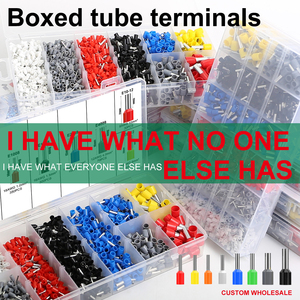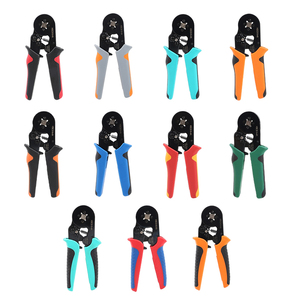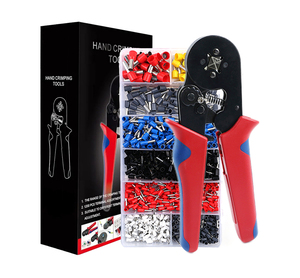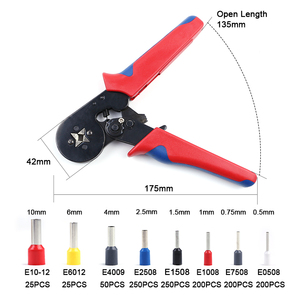
All categories
Featured selections
Trade Assurance
Buyer Central
Help Center
Get the app
Become a supplier

(825 products available)





































There are several crimping tools of stainless steel tubes that function differently. The main difference lies in their operation type, source of power, and application. Hence, the following are these types categorized based on their mode of operation.
They typically feature a metal lever that provides mechanical advantage and a die that shapes the metal into a fitting. As compression is achieved through manual labor, these tools are best suitable for smaller projects or jobs where the materials being crimped do not need heavy-duty crimping. In areas with restricted accessibility, these tools can be especially useful, since they are compact and light in weight.
Hydraulic crimpers, on the other hand, use fluid pressure to achieve the crimping effect, as in the case of a hydraulic pump. These power-assisted hand tools provide a stronger crimping force. Thus, suitable for larger fittings or thicker metals. Moreover, they are very useful in industrial and construction-related services.
These tools are operated by a rechargeable battery, which is a great advantage, particularly in providing cordless convenience. These crimping tools are typically hydraulic crimpers, for instance, battery-powered hydraulic crimpers. These tools are perfect where there is a lack of oxygen, but power is still needed for heavy areas to work in.
Pneumatic crimpers use an air compressor to generate the necessary crimping force. These are most appropriate for high-volume applications since they provide rapid and repeated crimping. These crimpers work well in environments where an air source is readily available.
For stainless steel tube crimper tools, the type of material used in making these tools and their durability are among the critical factors that determine their effectiveness and longevity, especially given that stainless steel is a tough material to operate with.
Carbon steel with chrome plating
Carbon steel is a commonly used material for crimping tools due to its great strength and resiliency. Often, carbon steel tools are chrome plated to give them better atmospheric protection, as this help prevents rusting. Hence, crimping tools with carbon steel are suitable for less grueling work. However, they will not withstand wear and tear like stainless steel.
High-carbon steel alloys
Several high-carbon steel alloys are hardened to increase the top surface hardness of the material. Therefore, tools from this material are both robust and retain shape, although brittle if not tempered well. Thus, this is ideal for durability under extreme crimping.
Chromium-molybdenum steel
Chromium-molybdenum steel, or Cr-Mo, offers an excellent compromise between strength and flexibility. In addition, it is highly resistant to wear and impact. Therefore, this alloy is usually found in premium-quality hydraulic and manual crimping tools. This material is suitable for heavy-duty applications, especially in industries working with tough materials.
Stainless steel
Nickel and chromium alloys provide stainless steel with its characteristic corrosion resistance. It is tough and durable, but more difficult to crimp and typically less sharp than other metals, so it is rarely used as a crimping tool material.
Maintain stainless steel tube crimping tools by cleaning after each use to remove debris and prevent corrosion, as well as lubricating the joints and moving parts with a suitable oil or lubricant to ensure smooth operation. Furthermore, inspect dies and crimping surfaces for wear and replace them as needed. Also, store these tools in a dry, protective case so they won’t get oxidized, especially when they are stainless steel crimping tools exposed to the atmosphere.
Crimping tools for stainless steel tubes are ideal for commercial use and are engaged in a variety of industrial applications. This is due to their strength, resistance to corrosion, and versatility in such areas as construction, marine, automotive, HVAC (heating, ventilation, and air conditioning), and plumbing.
Since stainless steel does not corrode easily in a marine environment, crimping tools are essential in the marine sectors that involve the installation or repair of wire ropes, cables, and tubing. For instance, crimping is used in the construction of stainless steel guardrails, rigging wires, and marine-grade stainless steel tubes for boats to help prevent rust and improve structural integrity. Hence, it is ideal for long-lasting structural and safety components in water.
These tools are used in the automotive industry to work with exhaust systems, fuel lines, and hydraulic systems where stainless steel tubing is commonly employed due to its durability and resistance to heat and chemicals. For instance, they help construct and maintain brake lines, fuel lines, and exhaust systems that have superior resistance to corrosion, thus providing great strength and longevity.
Crimping tools are particularly useful in the HVAC industry as well, where they are often used to connect stainless steel ducts, tubing, and pipes for ventilation, heating, and air conditioning. Stainless steel tubes that have been crimped help create airtight seals and secure connections in HVAC systems, offering greater protection from corrosion for an extended period.
For plumbing, crimping tools are engaged in the installation and repair of stainless steel pipe and tube fittings, such as the compression of stainless-steel pipes for water and gas lines. Because of its resistance to corrosion, plumbing using stainless steel tube crimping tools enhances water and gas lines in both indoor and outdoor.
Industries and constructions use crimping tools for piping systems, structural framework, and other applications that require durable and corrosion-resistant materials. Therefore, in building construction, stainless steel tubes crimped into railing, handholds, and structural reinforcements provide long-lasting strength and aesthetic value, e.g., in parking garages, tunnels, and bridges.
The selection of crimping tools for stainless steel tube depends on several factors. These factors determine which tool will produce optimal results.
This is to say that the size of the stainless steel tube and the type of crimped fittings or connectors will directly influence the die and tool size required. For instance, a manual crimping tool will suffice for small household or small-size tubes, while larger tubes will need hydraulic or pneumatic crimping tools requiring greater crimping force.
Stainless steel crimping tools must be manufactured from high-quality, durable materials. If stainless steels are to be used in a construction area or types with chemicals, high-quality carbon steel crimping tools should be chromium-plated or cr-mo alloy to provide better chemical and corrosion resistance, while at the same time affording superior strength and durability.
Consider the maintenance needs of the tools. For pneumatic or hydraulic crimpers in particular, they demand regular maintenance and checks of the air compressor and hydraulic fluid. Simple manual crimpers require little or no maintenance at all. Therefore, manual crimping tools can be most preferred in such areas that have little communication or remote areas, while hydraulic and pneumatic crimpers are ideal for heavy-duty work.
Crimping tools can range from simple manual tools to more complex hydraulic or pneumatic systems. Always determine whether the crimping tool is for short-term use or for projects that require long-term investment, for instance, construction work. If it is a one-off project or home DIY, a budget-friendly manual crimping tool can be used. However, if working on heavy commercial or industrial tasks, invest in high-quality hydraulic or pneumatic crimpers with long service life.
A1. Crimping tools for stainless steel tubes create secure fittings in industrial applications like plumbing, HVAC, and automotive systems for durable, leak-proof connections.
A2. There are manual, hydraulic, battery-operated, and pneumatic crimping tools catering to different needs, from light DIY projects to heavy industrial tasks, offering varying power and efficiency.
A3. Pneumatic crimping tools offer fast, consistent, and powerful crimping for large-scale or repetitive tasks, reducing labor time and increasing efficiency in industrial settings.
A4. These include marine, automotive, HVAC, construction, and industries because of their durability and resistance to corrosion.
A5. Consider tube size, project scope, and operational environment and requirements when selecting a crimping tool for a project.